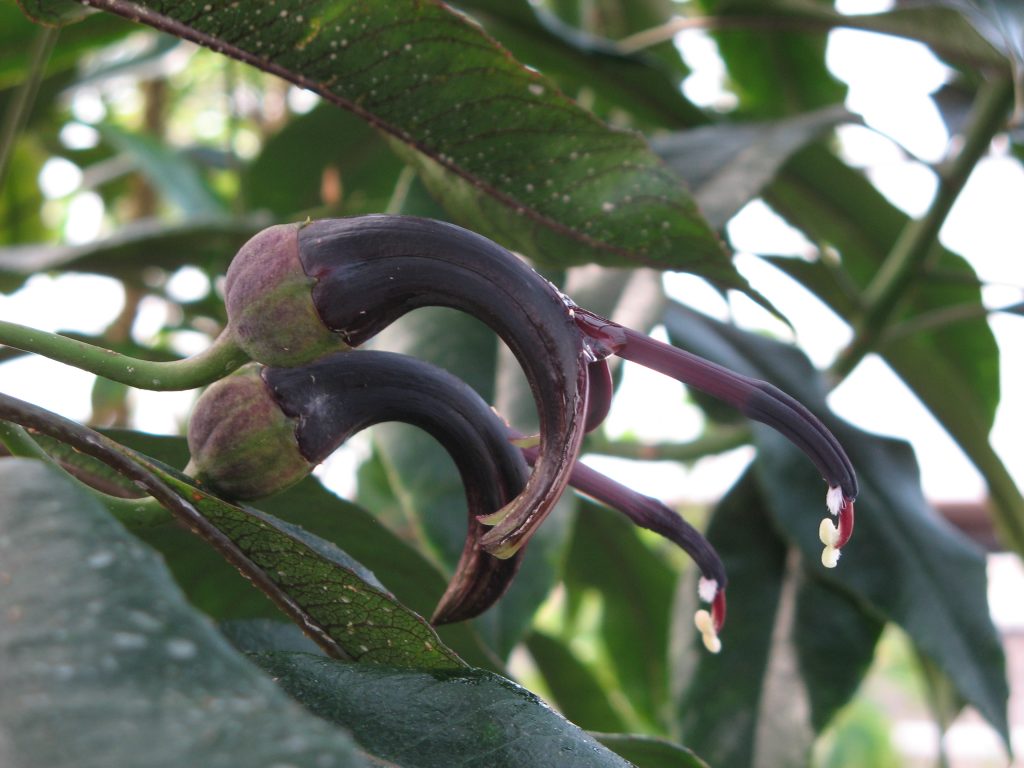‘Oha wai
Names
- ʻŌlelo Hawaiʻi: ʻOha wai
- Scientific: Clermontia peleana ssp. peleana
Conservation Status
- Federal and State Listed as Endangered
- IUCN Red List Ranking – Critically Endangered (CR)
- Hawai‘i Natural Heritage Ranking – Critically Imperiled (G1T1)
- Endemism ‐ Island of Hawai‘i
- Critical Habitat ‐ Designated
Species Information
ʻOha wai or Clermontia peleana of the bellflower family is an epiphytic shrub or tree 1.5 to 6 m (5 to 20 ft) tall which grows on ‘ōhi‘a, koa, Cheirodendron trigynum (‘olapa), and Sadleria spp. (ama‘u) . Berries of ssp. peleana are orange and 2.5 to 3 cm (1 to 1.2 in) in diameter (US Fish and Wildlife Service, 1994). This species is distinguished from others of the genus by its epiphytic growth habit, its small green calyx lobes, and its one lipped, blackish purple or greenish white corolla.
Distribution
Historically, Clermontia peleana ssp. peleana has been found only on the island of Hawai‘i on the eastern slope of Mauna Loa and the northeastern and southeastern slopes of Mauna Kea. Currently, this subspecies only occurs near Waiakaumalo Stream, by the Wailuku River, near Saddle Road, and between the towns of Glenwood and Volcano.
Habitat
This subspecies typically grows epiphytically in Montane Wet Forests dominated by koa, ‘ōhi‘a, and Cibotium spp., and in Sadleria spp. (tree ferns) at elevations between 530 and 1,160 m (1,740 and 3,800 ft).
Threats
- Feral pigs
- Roof or black rat (Rattus rattus)
- Flooding, and stochastic extinction
- Reduced reproductive vigor due to the small number of existing individuals.
References & Additional Resources
For more information and references visit the State Wildlife Action Plan factsheets. DOFAWʻs species pages and State Wildlife Action Plan fact sheets are provided for general information and are not meant to be a citable, original source of data. If you are a student, researcher, or writer looking for a citable source, please explore the references below or find other original data sources, rather than citing these webpages. The references below were provided by the authors of the State Wildlife Action Plan fact sheets at the time of drafting:
Center for Plant Conservation, 2005. National Collection of Endangered Plants. https://www.centerforplantconservation.org/ASP/CPC_NCList_Quick.asp [August 2005]. Hawai‘i Natural Heritage Program. 2005.
Hawaii Natural Heritage Program Search, https://www.hinhp.org [August 2005].
International Union for Conservation of Nature and Natural Resources, 2004, IUCN Red List of Threatened Species: Data Base Search, https://www.redlist.org/search/search‐basic.html [August 2005].
US Fish and Wildlife Service. 1994. Final Listing, Endangered ETWP; Determination of Endangered or Threatened Status for 21 Plants From the Island of Hawaii, State of Hawaii; Federal Register, Vol. 59, No. 43, (04‐MAR‐94 ), 59 FR 10305‐10325.
Federal Register I Vol. 59, No. 43 / Friday. March 4, 1994 / Rules and Regulations.
Wagner, W. L., D. R. Herbst, and D. H. Lorence. 2005. Flora of the Hawaiian Islands website. https://ravenel.si.edu/botany/pacificislandbiodiversity/hawaiianflora/index.htm [August 2005].
Wagner, W.L., Herbst, D.R., and Sohmer, S.H., 1999. Manual of the flowering plants of Hawaiʹi‐‐ Revised Edition. Honolulu, HI: University of Hawaii Press and Bishop Museum Press. 1853p.


